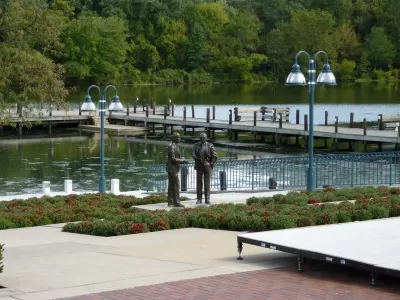The design for the planned city of Columbia, Maryland continues to influence new developments around the world.

James Rouse's vision for a model planned community, where people of different races live side-by-side, continues to inspire planners despite failing to live up to the high expectations of its builders and supporters. Doug Miller writing for Howard Magazine (via The Baltimore Sun), notes that almost 60 years on, the city of Columbia, Maryland continues to prosper even as the pressures of sprawling development, big box retail, and a middling mass transit system have hindered some of the early optimism for a new way of living.
“It was a terrific counter-measure to suburbia, something was desperately needed,” {architect Ralph Bennett] says, noting that his family has owned land in Howard County since 1954, though none that was included in Rouse’s voluminous purchases in advance of Columbia’s construction.
...
Rouse made a persuasive argument that the planned city would be far less costly to the county than standard suburban development and that tax revenue generated in Columbia offset the additional county expenditures necessitated by the booming population.
“Large lots and scattered developments increase the cost of providing many services,” including garbage collection, police, school buses water and sewer, Rouse’s primer on the Columbia project read.
Miller writes that while planned communities haven't taken off in the United States as much as some had hoped, they are seeing a resurgence in rapidly developing countries including China and India.
FULL STORY: Planned cities have gone out of style, but Columbia still influences urban design

Study: Maui’s Plan to Convert Vacation Rentals to Long-Term Housing Could Cause Nearly $1 Billion Economic Loss
The plan would reduce visitor accommodation by 25,% resulting in 1,900 jobs lost.

North Texas Transit Leaders Tout Benefits of TOD for Growing Region
At a summit focused on transit-oriented development, policymakers discussed how North Texas’ expanded light rail system can serve as a tool for economic growth.

Why Should We Subsidize Public Transportation?
Many public transit agencies face financial stress due to rising costs, declining fare revenue, and declining subsidies. Transit advocates must provide a strong business case for increasing public transit funding.

How to Make US Trains Faster
Changes to boarding platforms and a switch to electric trains could improve U.S. passenger rail service without the added cost of high-speed rail.

Columbia’s Revitalized ‘Loop’ Is a Hub for Local Entrepreneurs
A focus on small businesses is helping a commercial corridor in Columbia, Missouri thrive.

Invasive Insect Threatens Minnesota’s Ash Forests
The Emerald Ash Borer is a rapidly spreading invasive pest threatening Minnesota’s ash trees, and homeowners are encouraged to plant diverse replacement species, avoid moving ash firewood, and monitor for signs of infestation.
Urban Design for Planners 1: Software Tools
This six-course series explores essential urban design concepts using open source software and equips planners with the tools they need to participate fully in the urban design process.
Planning for Universal Design
Learn the tools for implementing Universal Design in planning regulations.
City of Santa Clarita
Ascent Environmental
Institute for Housing and Urban Development Studies (IHS)
City of Grandview
Harvard GSD Executive Education
Toledo-Lucas County Plan Commissions
Salt Lake City
NYU Wagner Graduate School of Public Service



























